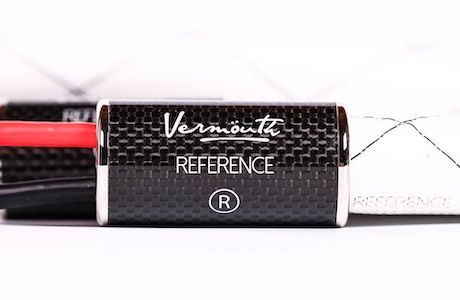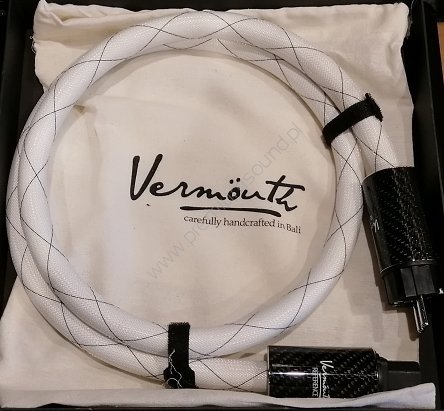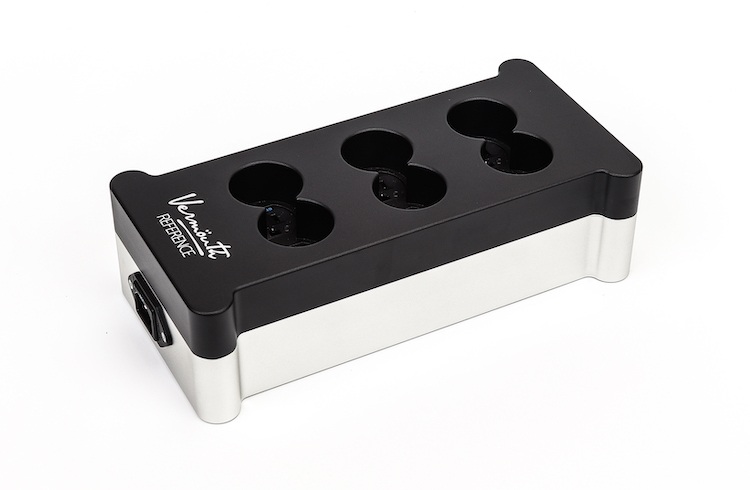
Vermouth Audio is based out of Bali, Indonesia, and is owned by Hendry Ramli. I highly recommend giving this audio cable brand a shot in your system. While the Vermouth brand is new to me, Hendry has offered exceptional cables at real-world prices since 2010.
When I indicated an interest in reviewing his cables, Joshua Masonsong of Believe High Fidelity Ltd., the US distributor for Vermouth Audio, sent me a whole slew of cables to review. They included the brand new USB cable, the Reference Power Cord, Reference interconnects, Reference speaker cables, and last but not least, a monster of a six-outlet Reference power distributor.
That’s a lot to cover, so this review will be in two parts. Part 1 focuses on POWER. Everything else will be in Part 2.
The Reference line of cables is the newest addition to the Vermouth family, It replaces the Black Pearl line on the top shelf. The Reference line came out in 2017, and many reviewers have had great things to say about them. I can tell you without a doubt that the Reference Power Cord made fundamental improvements to the quality of both my headphone rig and main speaker system.
Reference Power Cord

Like all of the Vermouth Audio cables, the Reference Power Cord uses braided OCC copper. Teflon insulates both the conductor and shield. It splits 39 UP-OCC multisized strands into two bundles surrounded by a braided shield. The power cord uses air tubing for spacing, and it is housed in an Al-Mylar sheath that reduces interfering noise. The plug is a Rhodium Furutech FI-28 with a carbon fiber shell body.
The Vermouth Reference line takes the “a little bit of everything” kind of approach. As in, it isn’t just Litz wire, or just ribbon, or just solid core, but rather, Hendry has custom-designed the cables to use a variety of UP-OCC strand sizes, and sometimes ribbon for some cables, to best meet the needs of the product. I think this approach has paid off.
Headphone Rig
I started with my headphone rig, which is just a Burson Soloist, the older model with the beefy power supply, and my old Audeze LCD-2 headphones. Then I used the PecanPi DAC (reviewed here) from Orchard Audio as the source and connected it to a Stager Silver Solid headphone and interconnect cables (reviewed here) and a WyWires USB cable.
Since the PecanPi DAC uses a wall wart power supply, I used the Vermouth Reference AC in to power the Soloist. I plugged the Reference AC cable to the Audience forte V8 Power Conditioner with an Audience forte f3 powerChord (reviewed here) into the wall. The Vermouth Reference AC replaced a second Audience forte f3 powerChord that had been providing power to the Soloist amp. The difference was significant and obvious once the Vermouth Reference Power Cord was in place.
Unquestionable Difference
At that moment I happened to be listening to Pretty Hate Machine from Nine Inch Nails. It was streaming from Spotify at a lossy bit rate. But even with this audiophile faux pas, The Vermouth Reference AC made an unquestionable difference. Trent Reznor’s voice no longer sounded constrained, strangled almost in the center of the sound stage, his voice filled out and was more three-dimensional, it had body and depth. The sound seemed to come from his whole throat and sometimes his chest instead of just from his nose.
That alone was good enough to win me over, but of course, there were other improvements. Other reviewers have also pointed out many of these, but most tend to comment on the improvements to the bass, and I agree. The Reference AC deepened the bass and also revealed more details. Not only was the bass more controlled, but it was deeper and the fidelity increased. The Reference AC also significantly cleaned up the top-end, where the cymbal, triangle, and other high-pitched percussion instruments reside. The sound was less scattered around the sound stage and more focused so that each instrument or sound had its space and more of the timber and tone of the instrument could be heard. And in an interesting way, the high-end was extended but spacious. Best I can compare it to in real life would be a drum set in a small venue versus a larger concert hall. In that there was just less distraction in the sound, and more of just the instruments themselves.
Soundstage Improvements
The Reference AC also made obvious improvements to the sound stage. I noticed better detail, tighter control, and less glare, all of which lead to better instrument distinction and placement. With headphones, the music naturally surrounds you more. It is right in your head, so to speak, versus out in front of you, with a standard stereo system. But, I have found that when things aren’t sounding their best, head phone can sound pinned to three locations in the sound stage; center, left and right. Like a “W”. With gaps between the left and right channels. This is significantly obvious with lower quality recordings, but even with great recordings, if the system isn’t at its best, the stage will suffer.
With the Reference AC, the sound stage of my system went from being a “W” to more of a flat line. Instruments and sounds that were only slightly panned off-center now seemed to have a more distinct space and presence. I also found this staging benefit to be true in my main system as well. Let’s talk about that now.
Changes for My Main System
When I moved from the headphone rig to my main system, I noticed that the effects that I heard with my headphones were still present. This was true even though my primary system is a pair of bookshelf speakers. First, I connected the Reference Power Cord to an Orchard Audio CRISPIN amplifier (Jack’s review here). Then, I used the Burson as the preamp with a Voodoo Platinum Dragon power cable to drive a pair of Lowther PMA2 Silver drivers in custom cabinets and MG Audio speaker cables. I also used the Stager Silver Solid interconnect with an Audience forte V8 Power Conditioner.
I used both the Orchard Audio PecanPi DAC and my Rega P3 with a SoundSmith Carmen cartridge and an MMP3 phono-amp as sources. The Reference Power Cord produced the same benefits in my main system as in my headphone system. They were even more apparent!
Swapping Things Around
Now, however, I had two components that could use the Reference AC, but only one Reference AC cord. I had to find out where the new cord sounded best.
Powering the CRISPIN Amplifier
My first try was to listen with the Reference Power Cord powering the CRISPIN amplifier. I used the Audience forte f3 powerChord for the Burson preamp. This combination sounded very good, but how would it sound if I swapped things around? Well, the answer is, it didn’t sound nearly as good. I lost much of the bass extension and soundstage benefits from the Reference Power Cord.
So I moved to my WyWires power cable. Again, I started with the WyWires in the Burson and the Vermouth in the CRISPIN. This sounded better, but what about swapped? Again, it was not as good. There was too much glare and the soundstage was more constricted with the WyWires than had been with the Vermouth Reference AC.
It was becoming obvious that the Vermouth Reference Power Cord needed to be last in the chain.
Using a Voodoo Platinum Dragon Cable
I had one more cable to try this with, my Voodoo Platinum Dragon cable. Some may argue that it is the most premium cable I have on hand. So I started with the Voodoo cable in the Burson, and now things were really starting to sound good. The soundstage actually got a bit better. The music had a good life to it. Vocals started to come forward just a hint more, and the detail seemed to increase.
So what about swapping? Here something interested happened. I like the sound of the Voodoo cable powering the CRISPIN, and the Reference Power Cable in the Burson. It had more life to it, and it was more exciting. However, it wasn’t as deep, and the lower mid-range lost detail. After a while, with my Lowther drivers and thin litz jumper cable in the cabinets, and a listening space that is not very well treated, the sound became exhausting.
Summing Up
Eventually, I switched back, mainly for the low-end benefits. I love the resonance and attack of drums with the Vermouth Reference Power Cord. It was just better, and I needed that. The other trade-offs also had their own benefits for longer listening sessions. Being less forward and vibrant gave the mid-range a bit more three-dimensional depth. I could listen to music for several hours without becoming fatigued. Exciting is great, but it can get overpowering after a while. The Reference AC seems to keep a bit tighter control on everything which in the long run is more enjoyable.
I haven’t heard a low-end sound that was this good since I had my hands on a pair of Granite Audio power cables. To this day, I regret returning them..
Vermouth Reference Power Distributor

Along with all of the cables, Joshua Masonsong of Believe High Fidelity Ltd., also sent me the Vermouth Reference Power Distributor, a monolith of a power strip. This beautiful beast has six power outlets and probably weighs more than my CRISPIN amplifier. It seems guaranteed to not tip over. I don’t think it will succumb to the weight and size of the Vermouth Reference Power Cord either, even if all six outlets are used at once.
There isn’t much press on this power distributor, but Hendy says this about the specs. “The internal wire used is the same as the Reference Power Cord. It is made of an aluminum CNC enclosure and uses Furutech GTX-D NCF (R) receptacles and Furutech FI-09 NCF (R) inlet. It is all direct without using any conditioner or filter. This is a great way to get the benefits of the Reference Power Cord to six outlets.”
How Does It Sound?
But how does it sound? Well, very good, but, I was limited to what I could actually plug into it. More on that in a bit, but now let’s talk about the benefits it added.
I immediately heard a darker, deeper background when I plugged in the Vermouth Reference Power Distributor versus plugging a component right into the wall or into the Audience forte V8 Power Platform. This helped increase the three-dimensional placement of instruments in acoustic music. The music also sounded more engaging and fast. Compared to the forte V8, the improvements were subtle, as the forte V8 is very nice, especially for its price. I do have to admit though, the Vermouth Reference Power Distributor made for some very delicious icing on an already extremely satisfying cake.
Limitations of Power Outlets
For me, the form factor of the power outlets is limiting. This may just be a financial gap, but a lot of my equipment uses wall wart plugs. The Rega, the PecanPi, the Raspberry PI music server, and the MMP3 phono amp, all use wall warts. So, I couldn’t plug any of them into the power outlets on the Reference Power Distributor. The outlets there are recessed into the body of the distributor by at least 20-30mm and are in the shape of round plugs.
This design does secure any round plug, like the Vermouth Reference Power Cord, but it limits everything else. I would really have liked to try all of my components plugged into it like I can with the Audience forte V8, but that was not to be. But, given that I have never once seen a high-end, like several thousand dollars phono amp, DAC, etc, with a wall wart plug. I doubt that this is going to be an issue to anyone purchasing the Vermouth Reference line.
In Summary
While all audio and equipment is relative, I have heard enough power cables in my time to feel confident in recommending the Vermouth Reference Cord to anyone, even those of us at the entry-level of this hobby. While the cable and the power distributor are both beefy, they do a great job of setting the foundation for all of the other aspects of the systems that I listened to them in. I’m secretly hoping I don’t have to return this review sample for a good while.
Congratulations to Hendy for both the reference cord and the power distributor. And, congratulations to Believe High Fidelity for recognizing a gem when you hear it!


2 thoughts on “Review: Vermouth Audio Cables and Power, Part 1”